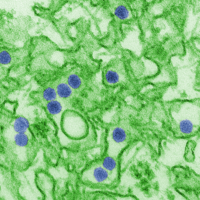
Photo from wikipedia
Zika virus (ZIKV) was first isolated in 1947 in a rhesus monkey from the Zika forest of Uganda. Until 2007, only 14 human cases were reported. The first large human… Click to show full abstract
Zika virus (ZIKV) was first isolated in 1947 in a rhesus monkey from the Zika forest of Uganda. Until 2007, only 14 human cases were reported. The first large human outbreak occurred in 2007 (Yap Island, Federated States of Micronesia, Pacific) followed by French Polynesia in 2013 and Brazil in 2015. The virus is mainly transmitted through Aedes mosquito bites, but sexual and post‐transfusion transmissions have been reported. Symptoms include low‐grade fever, maculopapular rash, conjunctivitis, myalgia, arthralgia, and asthenia. During the recent outbreaks in French Polynesia and Brazil, ZIKV infection has been associated with two major complications: microcephaly and Guillain–Barré syndrome. Since fetal infection includes other birth defects, congenital Zika syndrome has been used to define in utero infection. The majority of sexual transmission occurred from a symptomatic male to a female, but female‐to‐male and male‐to‐male transmission have been reported. Asymptomatic male‐to‐female transmission has also been described. Importantly, ZIKV RNA can persist at least 6 months in semen. The male urogenital tract may therefore act as a reservoir for the virus. ZIKV RNA was detected in a cervical swab of a patient 3 days after presenting the classic symptoms suggesting a potential tropism for the female genital tract. Long‐lasting presence of ZIKV RNA might not indicate that the individual is infectious but makes recommendation for couples potentially exposed to the virus and willing to conceive difficult. It will also be important to determine whether genital ZIKV infection might have a deleterious effect on male and female fertility.
Journal Title: American Journal of Reproductive Immunology
Year Published: 2017
Link to full text (if available)
Share on Social Media: Sign Up to like & get
recommendations!